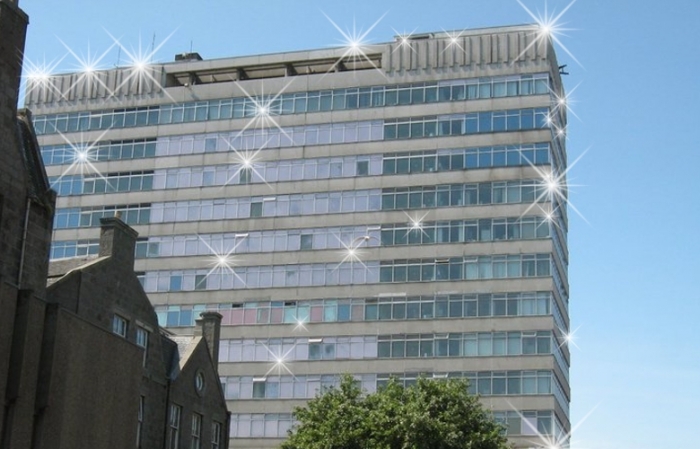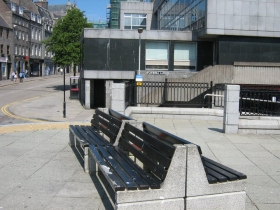With thanks to Mike Shepherd.
Peter Williamson was kidnapped as a child in Aberdeen harbour and taken to the American Colonies where he was sold as a slave.
On gaining his freedom, he was kidnapped by the Indians, living with them and eventually escaping from them. He then spent three years in the British Army fighting against the French and the Indians, only to be captured again, this time by the French.
As part of a prisoner exchange he was repatriated to Britain in 1757.
In Plymouth he was released from the army with a purse of six shillings. This was enough to get to him to York, by which time he was penniless.
He managed to persuade some local businessmen to publish his book, titled The Life and Curious Adventures of Peter Williamson, Who was Carried off from Aberdeen and Sold for a Slave. This sold very well and gave him enough money to return to Aberdeen in June 1758, fifteen years after being kidnapped.
He had several hundred copies of his book with him, some of which he managed to sell on the streets of Aberdeen. The book eventually came to the notice of Councillors and merchantmen in the city, and although nobody was named, they did not like what they read. The Procurator Fiscal lodged a complaint with the Provost and Magistrates, stating:
“that by this scurrilous and infamous libel … the corporation of the City of Aberdeen, and whole members whereof, were highly hurt and prejudged; and therefore that the Pursuer (Peter Williamson) ought to be exemplary punished in his person and goods; and that the said pamphlet, and whole copies thereof, ought to be seized and publicly burnt.”
A warrant was issued for his arrest. He was taken from his lodgings and brought before a Magistrate at the courthouse. Peter was asked to repudiate publicly everything he had said concerning the merchants of Aberdeen. Until he agreed, he was to be imprisoned and his books seized. After a short time in the Tolbooth (a jail in the Aberdeen Town House), he was bailed and stood for trial. On being found guilty, he was told to lodge a document with the court confessing to the falsity of the book and to pay a ten shilling fine, otherwise he would be imprisoned. This he reluctantly agreed to, leaving Aberdeen and moving to Edinburgh.
In a ceremony watched by the Dean of the Guild, the Town Clerk, the Procurator Fiscal and the Baillies, the offending pages were sliced from 350 of Williamson’s books and publicly burnt at the Mercat Cross by the town hangman. The remaining pages were never returned.
In Edinburgh, Peter contacted a lawyer and started planning for a legal challenge. He opened a coffee shop which became frequented by the Edinburgh legal fraternity and he started to teach himself Scots law. The year 1760 saw the start of an extended phase of courtroom battles against his persecutors in Aberdeen. In 1762, he was successful in getting the result of the Aberdeen trial reversed and was awarded costs and a £100 in damages.
The results of his investigations had revealed the names of the businessmen behind his kidnapping. These were Captain Robert Ragg, Walter Cochrane (the Aberdeen Town Clerk Depute), Baillie William Fordyce, Baillie William Smith, Baillie Alexander Mitchell, and Alexander Gordon, all local merchants with a share in the ship, Planter.
Further litigation ensued. Witnesses were found and they were mainly men who as boys had managed to escape kidnapping. The father of a boy who had sailed with Peter Williamson to the Americas testified. He said that while the Planter had been moored at Torry, his son had returned to him and refused to go back. He claimed that Captain Ragg and others involved had spoken again and again with him in the street, warning him that he would be sent to the Tolbooth if he didn’t send his son back to the ship. The boy went back.
The main incriminating evidence was the so-called “kidnapping book”. This was a ledger detailing all the expenses of the slave-ship venture. It mentioned Peter Williamson by name and included entries such as:
“To one pair of stockings to Peter Williamson, six pence; To five days of diet, one shilling and three pence.”
One entry read:
“To the man who brought Peter Williamson, one shilling and six pence.”
Eventually in 1768 the case was proved. Peter was awarded damages of £200 plus 100 guineas costs.
Child slavery was endemic in Aberdeen and elsewhere in the 1700s. The plantations in the American colonies were desperate for labour. The Book of Bon Accord (Robertson 1839) records that:
“The inhabitants of the neighbourhood dared not send their children into town, and even trembled lest they should be snatched away from their homes. For in all parts of the country emissaries were abroad, in the dead of night children were taken by force from the beds where they slept; and the remote valleys of the Highlands, fifty miles distant from the city, were infested by ruffians who hunted their prey as beasts of the chase.”
Skelton (2004) mentions that it was estimated that 600 boys and girls were abducted and sold for slavery between 1740 and 1760 in Aberdeen and the North-east. On the voyage alone that took Peter Williamson, there were 69 youngsters on board.
A BBC website accompanying a radio series on the history of the British Empire fills in some background from the period:
“Most accounts of British slaving date from the 16th century with the shipping of Africans to the Spanish Main. But less discussed is what happened to English and Scots eight, nine and ten year-olds in places like Aberdeen, London and Bristol. Many from those places were sold for forced labour in the colonies.
London gangs would capture youngsters, put them in the hold of a ship moored in the Thames and when the hold was full, set sail for America. Many authorities encouraged the trade. In the early 17th century authorities wanted rid of the waifs, strays, young thieves and vandals in their towns and cities. The British were starting to settle in Virginia. So that’s where the children went.
This was a time when it was common enough in Britain to have small children as cheap, or unpaid labour. In 1618 one hundred children were officially transported to Virginia. So pleased were the planters with the young labour that the then Lord Mayor, Sir William Cockayne, received an immediate order from the colony “to send another ship load.”
See: http://www.bbc.co.uk/radio4/history/empire/episodes/episode_36.shtml
Sources:
*Joseph Robertson: “The Book of Bon Accord”. Aberdeen 1839.
*Douglas Skelton: “Indian Peter. The extraordinary life and adventures of Peter Williamson”. Edinburgh, 2004.
*Peter Williamson “The Life and Curious Adventures of Peter Williamson, Who was Carried off from Aberdeen and Sold for a Slave”. York, 1757.
Read the full story here: The Life and Curious Adventures of Peter Williamson



